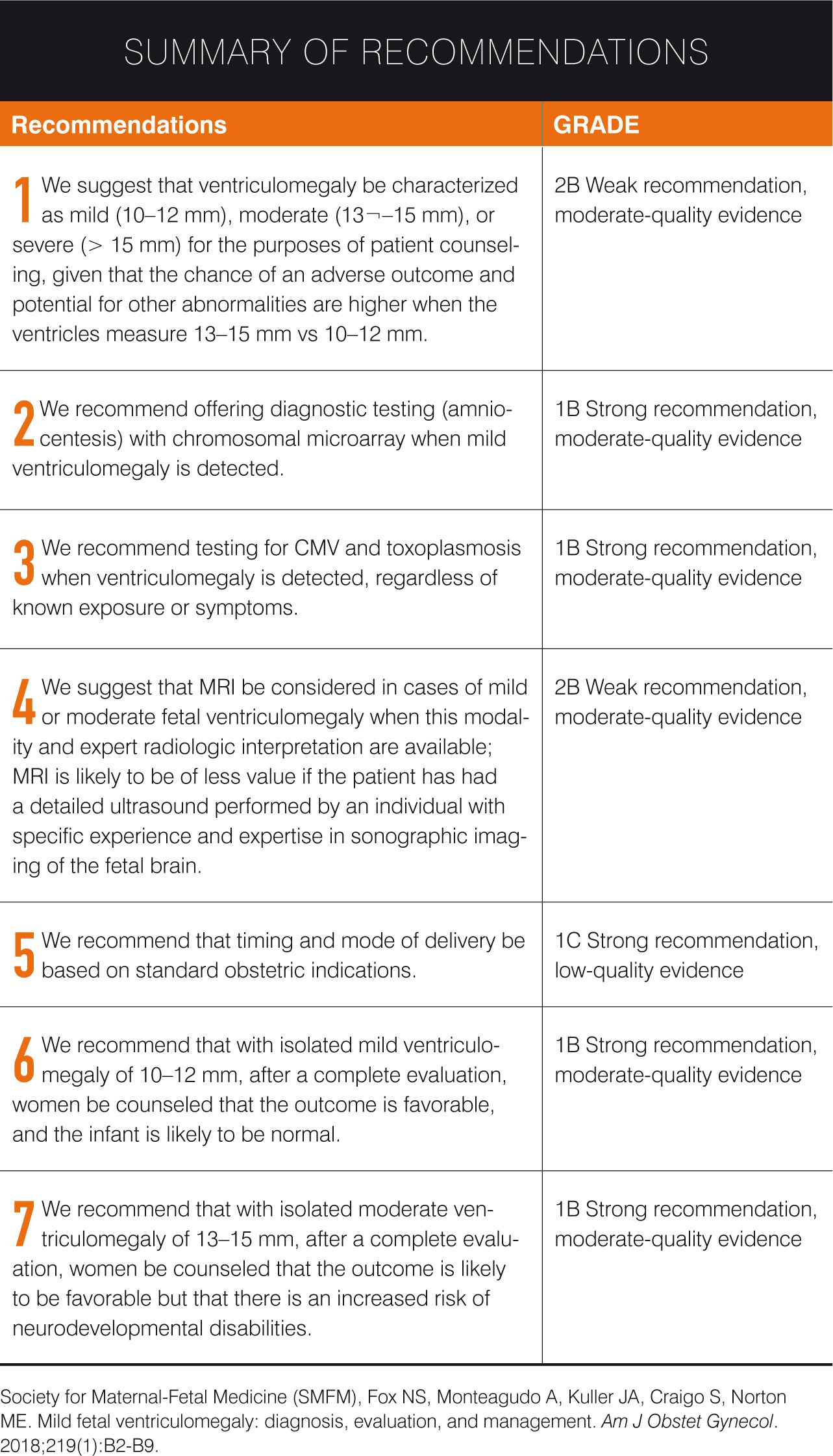Seven recommendations for mild fetal ventriculomegaly
Ventriculomegaly, or dilation of the fetal cerebral ventricles, is a relatively common finding on prenatal ultrasound. This summary of SMFM Consult Series #45 reviews key points for diagnosis, evaluation, and management of mild fetal ventriculomegaly.
Ventriculomegaly, or dilation of the fetal cerebral ventricles, is a relatively common ï¬nding on prenatal ultrasound. This summary of SMFM Consult Series #45 reviews key points for diagnosis, evaluation, and management of mild fetal ventriculomegaly.
Q| How is ventriculomegaly deï¬ned?
Fetal cerebral ventriculomegaly is defined as an atrial diameter ≥ 10 mm on prenatal ultrasound. Ventriculomegaly is typically categorized in one of two ways: mild (10–15 mm) or severe (> 15 mm); or as mild (10–12 mm), moderate (13–15 mm), or severe (> 15 mm). Because the chance of an adverse outcome and potential for other abnormalities are higher when the ventricles measure 13–15 mm vs 10–12 mm, the latter classification method should be used for the purposes of patient counseling. The incidence of mild to moderate fetal ventriculomegaly is approximately 1%.
Q| What are the causes of ventriculomegaly?
The differential diagnosis of ventriculomegaly is extensive and includes a normal variant as well as disorders associated with severe impairment. A thorough evaluation is critical to make the correct diagnosis and to provide an accurate prognosis.
Normal variation
Fetuses with a ventricular atrial diameter of 10–12 mm are found to have a normal postnatal evaluation in > 90% of cases. The chance that mild ventriculomegaly represents a normal variant decreases with increasing degrees of dilation. Mild ventriculomegaly is likely to represent a normal variant if no other structural abnormalities are noted and if aneuploidy screening or diagnostic genetic testing results are normal. Because it is not possible to determine with certainty that mild ventriculomegaly is truly isolated during pregnancy, normal variation is a diagnosis of exclusion that cannot be made with certainty until after birth.
Structural abnormalities
Structural abnormalities that can lead to dilation or enlargement of the lateral ventricles include agenesis of the corpus callosum, Dandy-Walker malformation, neural tube defects, cortical defects, and migrational abnormalities or heterotopia. Some structural central nervous system (CNS) anomalies, such as holoprosencephaly, hydranencephaly, porencephaly, or schizencephaly, and cystic lesions, such as arachnoid cysts, result in abnormal fluid collections in the fetal brain that may be misdiagnosed as ventriculomegaly, although these anomalies do not truly represent dilation of the ventricular system. In rare cases, a tumor or choroid plexus papilloma may result in overproduction of cerebrospinal fluid with resultant ventriculomegaly. Large isolated choroid plexus cysts may transiently dilate the fetal cerebral ventricles.
The most common cause of severe ventriculomegaly is aqueductal stenosis, which results from narrowing of the cerebral aqueduct of Sylvius located between the third and fourth ventricle, leading to progressive dilatation of the lateral and third ventricles. Aqueductal stenosis can be genetic or can result from fibrosis secondary to fetal infection (e.g., cytomegalovirus [CMV], toxoplasmosis, or Zika virus) or bleeding (e.g., intraventricular hemorrhage). A mass or congenital tumor can also lead to compression of the aqueduct with resultant ventriculomegaly. In many cases, the cause of aqueductal stenosis is unknown.
Infection
Approximately 5% of cases of mild to moderate ventriculomegaly are reported to result from congenital fetal infections, including cytomegalovirus (CMV), toxoplasmosis, and Zika virus. Many cases of ventriculomegaly associated with congenital infection demonstrate other sonographic features, including fetal growth restriction; periventricular, hepatic, and other intra-abdominal calcifications; echogenic fetal bowel; hepatosplenomegaly; ascites; meconium peritonitis; polyhydramnios, and microcephaly. However, these features may not be evident until later in gestation, and not all infected fetuses will have other sonographic signs.
Genetic disorders
Approximately 5% of fetuses with apparently isolated mild to moderate ventriculomegaly have an abnormal karyotype, most commonly trisomy 21. Another 10% to 15% have abnormal findings on chromosomal microarray. Although hydrocephalus is a component of several congenital syndromes, there are relatively few genetic causes of isolated ventriculomegaly or hydrocephalus. Syndromes typically associated with more severe ventriculomegaly as well as additional abnormalities that may be identified sonographically or by fetal magnetic resonance imaging (MRI) include Walker-Warburg, Bardet-Biedl, Meckel, Joubert, and hydrolethalus syndromes.
NEXT: How should a fetus with mild or moderate ventriculomegaly be evaluated?

Q| How should a fetus with mild or moderate ventriculomegaly be evaluated?
When mild or moderate ventriculomegaly is detected, further evaluation is indicated. Such evaluation is focused on determining whether additional structural (CNS and non-CNS) anomalies, genetic abnormalities, or congenital infection are present.
Ultrasonography
Incidence of additional CNS and non-CNS sonographic abnormalities identified in fetuses with mild or moderate ventriculomegaly ranges from 10% to 76% but appears to be < 50% in most studies. When ventriculomegaly is identified, a detailed ultrasound should be performed by a practitioner experienced in diagnosis of fetal anomalies. Careful attention should be given to intracranial anatomy including the lateral, third, and fourth ventricles; corpus callosum; thalami; germinal matrix region; cerebellum; and the cerebellar vermis. The fetal heart should be carefully examined, and fetal biometry should be assessed for evidence of growth restriction. Finally, a thorough inspection should be performed for signs of fetal infection, including intracranial or extracranial calcifications, hepatosplenomegaly, ascites, and fetal growth restriction.
Testing for genetic disorders
Diagnostic testing (amniocentesis) with chromosomal microarray should be offered when ventriculomegaly is detected. Cell-free DNA screening can be considered for women who decline diagnostic testing after counseling about the limitations of this approach. Women with prior normal screening test results, including cell-free DNA, should still be offered diagnostic testing due to the higher diagnostic yield.
Testing for fetal infectious etiologies
The woman’s history should be reviewed for symptoms suggestive of CMV infection, and exposure to potential sources of toxoplasmosis (e.g., outdoor cats, gardening, consumption of undercooked meat) and Zika virus should be assessed. A detailed travel history should be included in the evaluation. For women with a history of travel to any Zika-endemic area, testing according to the Centers for Disease Control and Prevention guidelines is recommended. Testing for CMV and toxoplasmosis is recommended when ventriculomegaly is detected, regardless of known exposure or symptoms. Testing can include maternal serology or polymerase chain reaction (PCR) on amniotic fluid. For women who decline amniocentesis, serum testing for CMV includes IgG and IgM, as does screening for toxoplasmosis
NEXT: What is the role of fetal MRI?
Q| What is the role of fetal MRI?
Fetal MRI can be useful in evaluation of ventriculomegaly because this modality can identify significant abnormalities not easily detected by ultrasound, such as cortical malformations and migrational abnormalities. The most common abnormality detected on MRI but missed on fetal ultrasound is agenesis of the corpus collosum. MRI may also be of benefit in assessing the extent of destructive injury in fetuses with known infection, hemorrhage, or ischemia, and when other sonographically evident CNS malformations, such as agenesis of the corpus callosum or Dandy-Walker malformation, are present.
MRI is most useful at > 22–24 weeks’ gestation, as milestones of CNS development become more evident with advancing gestation. The added value of MRI depends in part on the degree of ventricular dilation, as well as on the quality of the original ultrasound and whether a detailed neurosonography examination was performed by a provider with specific expertise. MRI can be considered in cases of mild or moderate fetal ventriculomegaly when this modality and expert radiologic interpretation are available. It is likely to be of less value if the patient has had a detailed ultrasound exam performed by an individual with specific experience and expertise in sonographic imaging of the fetal brain.
Q| What is the appropriate antenatal management of a pregnancy after mild to moderate ventriculomegaly is detected?
Follow-up ultrasound after initial detection of fetal ventriculomegaly is helpful to assess progression, stability, or resolution. The optimal timing and frequency of follow-up ultrasound examinations in the setting of mild to moderate ventriculomegaly is dependent on the initial gestational age at diagnosis as well as other clinical factors.
Women should receive counseling from a health care provider with specific expertise in prenatal diagnosis and prognosis of fetal ventriculomegaly. They should be informed that the prognosis varies widely based on the exact findings of the complete prenatal and postnatal evaluation. If ventriculomegaly is progressive, consultation with a pediatric neurosurgeon may be useful, as some neonates may require postnatal surgical intervention, such as ventriculoperitoneal shunting. Overall, the likelihood of mild to moderate ventriculomegaly requiring surgical intervention after birth is low.
Antepartum fetal testing is not likely to be beneficial in the setting of mild to moderate ventriculomegaly, as this abnormality is not typically associated with placental insufficiency, unless other abnormalities such as fetal growth restriction or amniotic fluid abnormalities are present.
Q| What is the optimal timing and mode of delivery for fetuses with ventriculomegaly?
There is no evidence that preterm or cesarean delivery improves maternal or neonatal outcomes in the setting of mild to moderate ventriculomegaly. Timing and mode of delivery should therefore be based on standard obstetric indications. Given the potential for mild to moderate ventriculomegaly to be associated with long-term adverse neurodevelopmental outcomes, the primary pediatrician should be made aware of this prenatal finding.
Q| What is the prognosis for infants with mild ventriculomegaly?
The prognosis for infants with mild to moderate ventriculomegaly is widely variable and depends on presence or absence of structural or genetic abnormalities, fetal infection, and severity of ventricular dilation. After a complete evaluation, if the ventriculomegaly is mild and isolated, the outcome is most commonly normal. With isolated moderate ventriculomegaly of 13–15 mm, after a complete evaluation, the outcome is likely to be favorable, but there is an increased risk of neurodevelopmental disabilities. In the setting of mild to moderate ventriculomegaly with associated abnormalities, the prognosis primarily depends on the specific abnormality rather than the degree of ventricular dilation.
Progression is also a factor in outcomes. In cases in which ventriculomegaly progresses, the rate of adverse outcomes is reported to be as high as 44%, while outcomes are normal in > 90% of cases in which ventriculomegaly improves. In most cases, risk of recurrence of isolated ventriculomegaly in future pregnancies is low. In cases with an underlying cause, such as a chromosomal or genetic condition, risk of recurrence will depend on the specific diagnosis.

Using technology tools for optimal perinatal outcomes
May 6th 2022At the 2022 American College of Obstetricians and Gynecologists Annual Clinical and Scientific Meeting, 3 physicians talked about how apps, AI and remote blood pressure monitoring could improve perinatal outcomes and move the diversity, inclusion, and equity needle for women forward.
Read More
